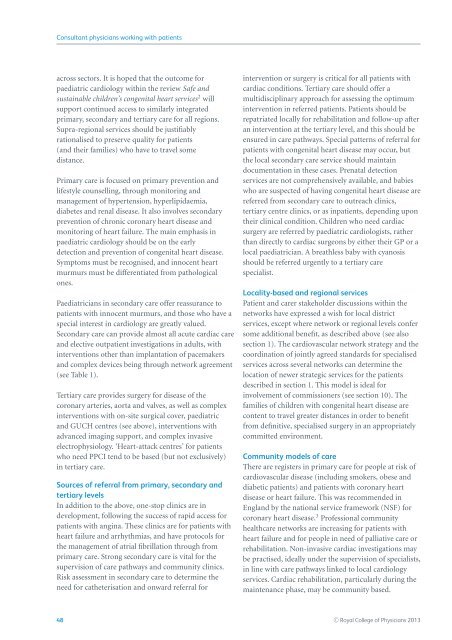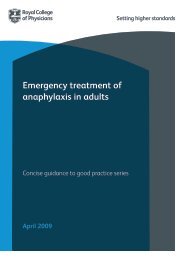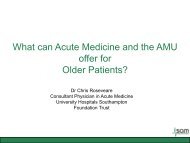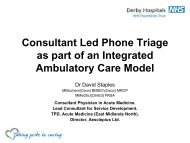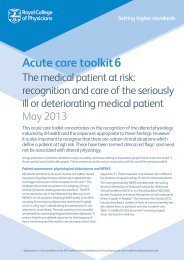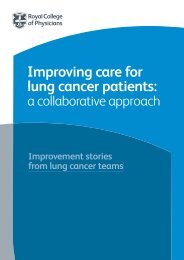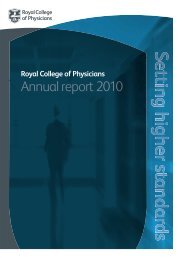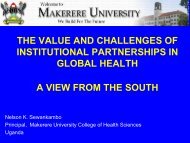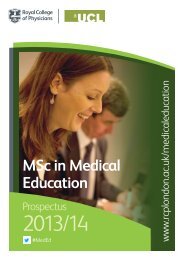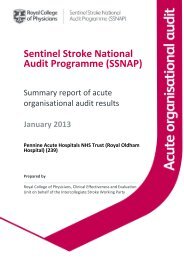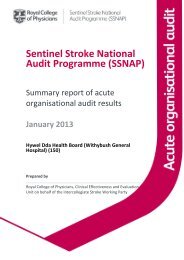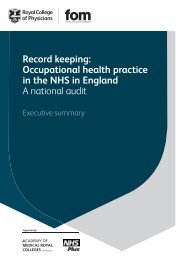Consultant physicians working with patients - Royal College of ...
Consultant physicians working with patients - Royal College of ...
Consultant physicians working with patients - Royal College of ...
You also want an ePaper? Increase the reach of your titles
YUMPU automatically turns print PDFs into web optimized ePapers that Google loves.
<strong>Consultant</strong> <strong>physicians</strong> <strong>working</strong> <strong>with</strong> <strong>patients</strong>across sectors. It is hoped that the outcome forpaediatric cardiology <strong>with</strong>in the review Safe andsustainable children’s congenital heart services 2 willsupport continued access to similarly integratedprimary, secondary and tertiary care for all regions.Supra-regional services should be justifiablyrationalised to preserve quality for <strong>patients</strong>(and their families) who have to travel somedistance.Primary care is focused on primary prevention andlifestyle counselling, through monitoring andmanagement <strong>of</strong> hypertension, hyperlipidaemia,diabetes and renal disease. It also involves secondaryprevention <strong>of</strong> chronic coronary heart disease andmonitoring <strong>of</strong> heart failure. The main emphasis inpaediatric cardiology should be on the earlydetection and prevention <strong>of</strong> congenital heart disease.Symptoms must be recognised, and innocent heartmurmurs must be differentiated from pathologicalones.Paediatricians in secondary care <strong>of</strong>fer reassurance to<strong>patients</strong> <strong>with</strong> innocent murmurs, and those who have aspecial interest in cardiology are greatly valued.Secondary care can provide almost all acute cardiac careandelectiveoutpatientinvestigationsinadults,<strong>with</strong>interventions other than implantation <strong>of</strong> pacemakersand complex devices being through network agreement(see Table 1).Tertiary care provides surgery for disease <strong>of</strong> thecoronary arteries, aorta and valves, as well as complexinterventions <strong>with</strong> on-site surgical cover, paediatricand GUCH centres (see above), interventions <strong>with</strong>advanced imaging support, and complex invasiveelectrophysiology. ‘Heart-attack centres’ for <strong>patients</strong>who need PPCI tend to be based (but not exclusively)in tertiary care.Sources <strong>of</strong> referral from primary, secondary andtertiary levelsIn addition to the above, one-stop clinics are indevelopment, following the success <strong>of</strong> rapid access for<strong>patients</strong> <strong>with</strong> angina. These clinics are for <strong>patients</strong> <strong>with</strong>heart failure and arrhythmias, and have protocols forthe management <strong>of</strong> atrial fibrillation through fromprimary care. Strong secondary care is vital for thesupervision <strong>of</strong> care pathways and community clinics.Risk assessment in secondary care to determine theneed for catheterisation and onward referral forintervention or surgery is critical for all <strong>patients</strong> <strong>with</strong>cardiac conditions. Tertiary care should <strong>of</strong>fer amultidisciplinary approach for assessing the optimumintervention in referred <strong>patients</strong>. Patients should berepatriated locally for rehabilitation and follow-up afteran intervention at the tertiary level, and this should beensured in care pathways. Special patterns <strong>of</strong> referral for<strong>patients</strong> <strong>with</strong> congenital heart disease may occur, butthe local secondary care service should maintaindocumentation in these cases. Prenatal detectionservices are not comprehensively available, and babieswho are suspected <strong>of</strong> having congenital heart disease arereferred from secondary care to outreach clinics,tertiary centre clinics, or as in<strong>patients</strong>, depending upontheir clinical condition. Children who need cardiacsurgery are referred by paediatric cardiologists, ratherthan directly to cardiac surgeons by either their GP or alocal paediatrician. A breathless baby <strong>with</strong> cyanosisshould be referred urgently to a tertiary carespecialist.Locality-based and regional servicesPatient and carer stakeholder discussions <strong>with</strong>in thenetworks have expressed a wish for local districtservices, except where network or regional levels confersome additional benefit, as described above (see alsosection 1). The cardiovascular network strategy and thecoordination <strong>of</strong> jointly agreed standards for specialisedservices across several networks can determine thelocation <strong>of</strong> newer strategic services for the <strong>patients</strong>described in section 1. This model is ideal forinvolvement <strong>of</strong> commissioners (see section 10). Thefamilies <strong>of</strong> children <strong>with</strong> congenital heart disease arecontent to travel greater distances in order to benefitfrom definitive, specialised surgery in an appropriatelycommitted environment.Community models <strong>of</strong> careThere are registers in primary care for people at risk <strong>of</strong>cardiovascular disease (including smokers, obese anddiabetic <strong>patients</strong>) and <strong>patients</strong> <strong>with</strong> coronary heartdisease or heart failure. This was recommended inEngland by the national service framework (NSF) forcoronary heart disease. 3 Pr<strong>of</strong>essional communityhealthcare networks are increasing for <strong>patients</strong> <strong>with</strong>heart failure and for people in need <strong>of</strong> palliative care orrehabilitation. Non-invasive cardiac investigations maybe practised, ideally under the supervision <strong>of</strong> specialists,in line <strong>with</strong> care pathways linked to local cardiologyservices. Cardiac rehabilitation, particularly during themaintenance phase, may be community based.48 C○ <strong>Royal</strong> <strong>College</strong> <strong>of</strong> Physicians 2013


